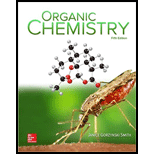
Concept explainers
Interpretation: The possible resonance structures for the given cation and the structure that makes the largest contribution to the resonance hybrid is to be drawn.
Concept introduction: Most of the organic structures cannot be represented using single Lewis structure. Therefore, there exists more than one Lewis structure for representing a molecule or ion. These structures are known as resonance structures. These are the hypothetical structures and do not specify the exact structure. These resonance structure combine together to give resonance hybrid that is lower in energy and is the most stable structure.
The delocalization of electrons results in the formation resonance structure.
The stability of resonance structures depends upon the following rules:
• The stability of resonance structure is more if it possesses more bonds and fewer charges.
• Resonance structure will be more stable if atoms of the resonance structure have complete octet.
• The stability of resonance structure is more if negative charge is on more electronegative atom
Want to see the full answer?
Check out a sample textbook solution
Chapter 16 Solutions
Package: Organic Chemistry with Connect 2-year Access Card
- For each proposed set of resonance structures: a. (E) Add curved arrows (starting from left) to show how each successive r.s. was generated. b. Cross out any resonance structures that are NOT important, and explain your reasoning.arrow_forwardWhich of the given resonance structures (A, B,or C) contributes most to the resonance hybrid? Which contributes least?arrow_forwardWhich of the given resonance structures (A, B, or C) contributes most to the resonance hybrid? Which contributes least?arrow_forward
- For each example, specify whether the two structures are resonance contributors to the same resonance hybrid.arrow_forwardAll resonance structures with arrow. Major resonance?arrow_forwardDraw all reasonable resonance forms for the following molecules. Hypothesize on which of the forms contributes most to the overall resonance hybrid in a couple of sentences for each compound.arrow_forward
- draw the resonance for the following structures?arrow_forwardDraw all contributing resonance structures for the molecule shown below. Circle themajor resonance contributor.arrow_forwardThe molecule shown has an unusually stable anion. In the box below please draw all the resonance structures that show the delocalization fo the anion that is generated when a proton is removed. Provide an explanation for this unusual stability.arrow_forward
- The anion drawn below displays resonance and has two main contributing structures. One ofthe two contributing structures is displayed. Draw the second contributing structure in theempty box below:arrow_forwardProvided is the first and last resonance. Draw the missing resonance forms, then propose the corresonding resonance hybrids of each molecule. Show the movement of electrons using appropriate arrows.arrow_forwardThe following compounds a) are NOT resonance structures, they aredifferent compounds. b) The following compound is aromaticarrow_forward
 Organic Chemistry: A Guided InquiryChemistryISBN:9780618974122Author:Andrei StraumanisPublisher:Cengage Learning
Organic Chemistry: A Guided InquiryChemistryISBN:9780618974122Author:Andrei StraumanisPublisher:Cengage Learning
